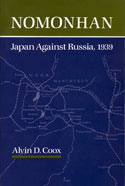Nomonhan
Japan Against Russia, 1939
The undeclared border war in remote eastern Mongolia at Nomonhan during May-September 1939 is little known to most. It had tremendous influences on military history and world events and the Pacific War of 1941-1945.
Author Alvan Coox's monumental "Nomonhan" is the culmination of thirty year of research and interviews with Japanese veterans who entrusted him with their memories, diaries and revaluations while the author lived in Japan. As a work of historical research and writing, the final product represents a life's work of study and dedication. A Stanford grant allowed Coox to process all his material into one comprehensive volume.
The book starts with the history of Manchuria (Manchukuo) and the military clashes and border incidents of the 1930s, and the escalation of hostilities by both the Soviets and Japanese Kwangtung Army in Manchuria.
At the far western border with Mongolia, a border skirmish developed into an undeclared war, known to the Soviets as the "Battle of Khalkhin Gol", and to the Japanese as the "Nomonhan Incident". The Japanese claimed their border was the Khalkhin Gol, while the Mongolians and Soviets claimed the border was east of Nomonhan.
After Mongolian cavalry crossed the disputed border in May 1939, Japanese responded by occupying the disputed area. This border skirmish developed into a undeclared war that lasted from May to August, with escalation by both sides to include aircraft, tanks, artillery and troops. The battle was between two sides: the Mongolians and Soviets versus the Japanese and Kwangtung and Manchukuo Armies. The coverage of the May-August combat phase is told nearly minute-by-minute across the entire front.
Both sides over claimed victories and suppress news of their own their losses. The book ends with an extensive analysis of the battle and aftermath, and fates of commanders and men on both sides. The story of Nomonhan is placed into context with events following, as the book continues to tell the story of Manchuria until the end of World War II, when Soviet forces attacked during "August Storm" in 1945 at the closing days of the war.
Heavily footnoted, the book's notes and appendixes span over 150 pages. Other appendixes include Japanese cabinets, war ministry and command structure, rosters, casualties, order of battle for both the Soviet and Japanese sides.
At over 1,200+ pages, this book is not for readers with a passing interest in the subject. Instead, this book is a comprehensive study of the political events that proceeded the battle, a comprehensive documentation of the combat and aftermath.
Review by Justin Taylan
Return to Book Reviews | Add a review or submit for review
|
